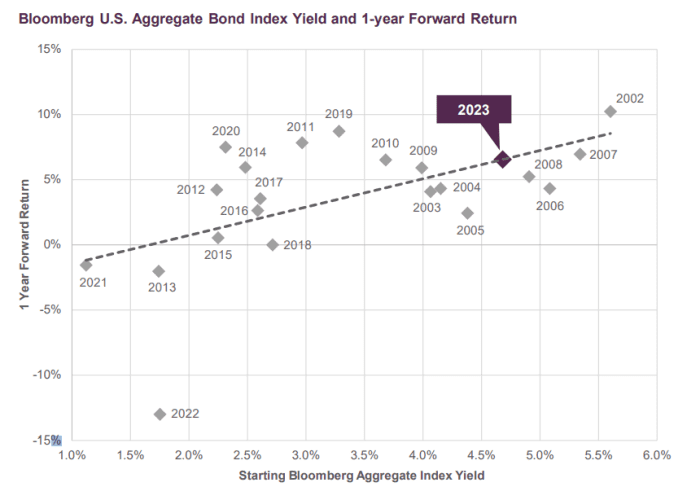After an awful year, a straightforward strategy has been shaping up for investors to get an estimated 6% return in the bond market, according to Guggenheim Partners.
The Federal Reserve’s rapid pace of interest rate hikes since March punished investors in both stocks and bonds, but the central bank’s efforts look to be paying off, at least on the inflation front.
That’s a big reason why Guggenheim now expects to see high-quality bonds return nearly 6% in 2023.
The team looked at this year’s starting yield of the benchmark Bloomberg U.S. Aggregate Bond Index, known as the “Agg,” and compared it with 1-year performance (see chart) over the past 20 years. It suggests the Agg could produce a near 6% total return in 2023, the best since 2008.

Guggenheim economist sees potential for a near 6% return this year for the benchmark “Agg” bond index.
Guggenheim Investments, Bloomberg
“The Fed’s aggressive tightening cycle drove a painful resetting of bond yields in 2022, but the upshot is that the central bank has put ‘income’ back in fixed income, thereby improving its return prospects,” Brian Smedley, chief economist, and his team at Guggenheim wrote, in a new client note.
To be sure, the Agg’s more than -10% negative return in 2022 was one for the history books. But the iShares Core U.S. Aggregate Bond ETF,
AGG,
which tracks the benchmark, already was 3.2% higher on the year through Friday, while the S&P 500 index
SPX,
was up 6% for the same stretch, according to FactSet.
Costlier borrowing costs aim to put a damper on spending by consumers and businesses, while helping the Fed tame inflation, ideally without triggering a recession.
A gauge of U.S. inflation, the Fed’s preferred PCE index, on Friday showed a further easing of price pressures in December to a 5% annual rate from last summer’s 7% peak, potentially opening the door for the Fed to soon stop raising interest rates.
Fed officials next week are expected to raise rates by a smaller 25 basis points next week. The Fed funds rate currently sits in a 4.25%-4.5% range, the highest since 2007.
While a recession is widely anticipated in 2023, recent economic data bolstered hopes that one might be avoided. It also has investors guessing at how long the Fed might need to keep rates high to get inflation headed back down to its 2% annual target.
The benchmark 10-year Treasury yield
TMUBMUSD10Y,
was back above 3.5% on Friday, after climbing as high as 4.2% in October, according to Dow Jones Market Data. Bond prices and yields move in the opposite direction.
If the U.S. slips into recession, Guggenheim’s team also sees a silver lining in bonds, since it “could boost returns further, if an investor flight to safety drives bond yields lower.”
Source: https://www.marketwatch.com/story/how-to-get-a-6-return-in-bonds-this-year-according-to-guggenheim-11674852462?siteid=yhoof2&yptr=yahoo
